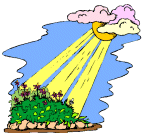|
Land Plants
 Excessive UV radiation inhibits the growth processes of almost all green plants. There is concern that ozone depletion may lead to a loss of plant species and reduce global food supply. Plants form the basis of the terrestrial food web, prevent soil erosion and water loss, and are the primary producers of oxygen and a primary removal sink for carbon dioxide, a greenhouse gas. Excessive UV radiation inhibits the growth processes of almost all green plants. There is concern that ozone depletion may lead to a loss of plant species and reduce global food supply. Plants form the basis of the terrestrial food web, prevent soil erosion and water loss, and are the primary producers of oxygen and a primary removal sink for carbon dioxide, a greenhouse gas.
Exposure to UV radiation may have a dramatic effect on terrestrial plant life, although the impacts are at present poorly understood. Absorption of UV radiation varies widely from one organism to the next. In general UV radiation affects plant growth by reducing leaf size and limiting the area available for energy capture during photosynthesis. Plant stunting and a reduction in total dry weight are also typically seen in UV-irradiated plants, with a reduction in the nutrient content and the growth of the plants, especially in the pea and cabbage families. A reduction in quality of certain types of tomato, potato, sugar beet and soya bean has also been observed. Forests also appear to be vulnerable. About half of the species of conifer seedlings so far studied have been adversely affected by UV radiation. Although old needles are able to protect themselves by strengthening their outer wax coating and by increasing the amount of protective pigment, young growing pine needles in contrast, suffer easily. Indirect changes caused by UV radiation, such as flowering and germination rates, changes in plant form and how nutrients are distributed within the plant, may be more important than the damaging effects of the radiation itself.
Reliable scientific information on the effects of UV radiation on plants however, is limited. Only 4 out of 10 terrestrial plant ecosystems (temperate forest, agriculture, temperate grassland, and tundra/alpine ecosystems) have been studied. In addition, much of the existing information comes from greenhouses where plants are more sensitive to UV radiation than those grown outdoors. There are indications that some weeds are more UV-resistant than crops. Many organisms have developed mechanisms for protecting themselves against over-exposure to UV radiation, for example by shielding themselves with pigment and repairing damaged DNA or plant tissue. However, for many organisms these mechanisms may not be sufficient to protect against increased levels of UV radiation as a result of ozone depletion.
Exposure tests made in USA and Australia have showed that over one hundred species of land plant could be sensitive to increases in UV radiation as a result of stratospheric ozone depletion. Some research has suggested that a 25% ozone depletion could result in a comparable reduction in total soya bean crop yield. International research has revealed that some species of rice suffer from even minor increases in UV radiation. Research into the efficient breeding and cultivation of strong species may help to offset some of the damaging effects of stratospheric ozone loss.
|

